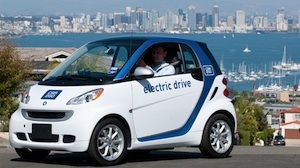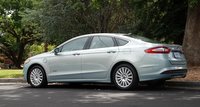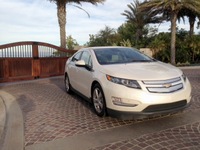The Danger of the Promise of the Imagined Future
Automobile sales are difficult to predict, even in the aggregate, where you’re guesstimating total sales for the year. When you drill down to a more volatile portion of the market like EV sales, it gets even less reliable. This is why at Clean Fleet Report we stay away from predictions, especially those several years out. Here’s a good example of why we follow this policy and will continue to focus our reporting on what’s happening right now, not in the unpredictable future.
Ceres and Citi Investment Research & Analysis took a look at electric vehicle sales back in March of 2011 and boldly predicted where the market would be in four years. That year was the first for electric cars — the Nissan Leaf and Chevy Volt — were just appearing, but other companies were expected to join in soon (Tesla had just launched its electric Roadster and Fisker’s plug-in hybrid was expected soon). Well, here we are four years later. Let’s see how the numbers stack up.
First a bit about who “they” are and what they were predicting. Citi Bank worked with Ceres, an environmental organization; Baum and Associates, auto industry analysts; the Rutgers University School of Planning & Public Policy; and the University of Michigan Transportation Research Institute. They did an overview of the state of the electric vehicle industry and focused on individual company product plans, technology issues and government policies. The goal was to provide investment advice, which should serve as a cautionary tale when you look at how the predictions turned out.
Future EV Sales
The forecast was that more than 100 models would be on the market by this year, which included hybrids as well as plug-in hybrids, full battery electrics and fuel cell vehicles. The inclusion of conventional hybrids is the only thing that saves this report from being completely off the mark, although it did have a good sense of several of the models that would be offered by this year, including the Hyundai Tucson FCEV. Other than that, it’s easier to pick out the misfires that came from believing some the press release of 2011. Among the battery electric cars that were around in 2011 that are no longer a factor in the market:
• Myers Motors (inheritors of the Corbin Sparrow single-seat EV)
• Tesla Roadster (retired after 2,400 units)
• BYD e6 (other than a few demos running around in government fleets)
• Coda sedan (RIP)
• Ford Transit Connect (Azure Dynamics RIP)
• Mini-E (retired in favor of the Active-E and then the i3)
That leaves the survivors—the Mitsubishi i-MiEV, Nissan Leaf and Smart Fourtwo.

Of the expected EVs, there also have been several no-shows or limited runs, including:
• CT&T NEV (a Korean neighborhood electric vehicle that never happened)
• Infiniti sedan
• Myers Motors DUO
• Peugeot Urban EV*
• Renault Fluence
• Renault Kangoo
• Think City (RIP)
• ZAP Alias
• Audi e-tron (still coming according to Audi)
• Fiat Doblo
• Lexus LF-A
• Ram Pickup
• Renault City Car*
• Renault Urban EV*
• Scion iQ (here and gone)
• Toyota Prius full electric
• Volkswagen E-Up* (possible U.S. model, surplanted by the e-Golf)
To be fair, the asterisked models were labeled Europe only, but not all of them appeared there, either. Finally, Citi had a list of “potential” models, which we’ll cut them some slack for, since they hedged their bets. The no-shows there are mostly small companies that haven’t made it along with a couple majors:
• Green Tech
• Lexus RX
• Nissan sporty car
• Reva NXT
• Subaru R1E
• Volvo C30
• V-Vehicle
Citi had similar issues with the plug-in hybrids and fuel cell vehicles. But they also failed to foresee many of the vehicles now on the market, so one could say it all comes out in the wash. All of this is just to point the difficulty in looking into the future, even just four years down the road, and why we look very skeptically on any such predictions.
Finally, the report also forecasts production volumes and market share. Here’s their take from 2011, followed by the reality at the end of 2014 (ironically also using Baum & Associates data in large part).
Forecast
Type – # of models – Volumes – % of “EV” Market
Hybrid – 57 – 518,200 – 55.2%
Full Electric – 37 – 215,200 – 22.9%
Plug-in Hybrid – 18 – 200,500 – 21.3%
Full Cell – 6 – 5,700 – 0.6%
Dec. 2014 (sales for year)
Hybrid – 45 – 452.152 – 79.2%
Full Electric – 13 – 63,325 – 11.1%
Plug-in Hybrid – 9 – 55,357 – 9.7%
Fuel Cell – 1 – Unknown – 0.0%
The market share story actually played out close to predictions, which may demonstrate that the market for these cars is developing, just at a slower rate than expected or hoped.
The 2011 study predicted Toyota would lead the market, followed by Ford, Nissan, Honda and GM, taking almost 80 percent of the market among five marques. Entering 2015, the race was very

similar, with Toyota dominating the volume hybrid market (66.8%), followed by Ford at 13.3%, Honda at 6.8%, Hyundai at 6.6%, GM at 3.5% and Nissan at 2.3%. The smaller volume full-electric market has Nissan leading at 41.8%, followed by Tesla 25.6% (2.9% of the overall “electric” market, about what was predicted), BMW 13.6% (1.2% of overall “electric” market, again about what was predicted, Daimler at 9.1% and VW at 3.2%. The plug-in hybrid market has GM leading at 41.6%, Ford at 37.4%, Toyota at 12.7%, BMW at 4.1%, VW at 2.5% and Honda at 1.6%. So the bottom line is the market has lost a couple potential players (Fisker, which was predicted to take 5.5% of the market, and Myers Motors, which was expected to take 1.2% of the market. Instead, because the conventional hybrid market continues to dominate in volume, Toyota has an even larger market share with the rest divided among other major automakers. Other than Tesla’s meager share, no new manufacturers have emerged to take on these new segments.
Forecasts were all over the map, but it is the high-volume models that threw off the projections the most. The Prius actually exceeded expectations, that is, if you count the whole Prius “family.” The Citi forecast showed the Prius at 150,000 units in 2015. The original Liftback sold 122,776 in 2014, while the “V” added 30,762 and the “c” model another 40,570. The Camry Hybrid was pegged at 40,000 units and it did come in just a shade under that number in 2014.

Among full electrics, the Nissan Leaf was expected to sell 90,000 units, but in 2014 it sold only 30,200. The other expected volume electric was the Tesla Model S, which didn’t hit the 22,500 number that was projected (delivering only 16,550 in the U.S.). Plug-in models were the furthest off, with the Volt selling 18,805 when it was forecast to sell 55,000; the Prius Plug-In was supposed to hit 55,000 units in 2015, but in reality in 2014 Toyota only sold 13,264; finally, the Fisker Nina (40,000 units) never made it off the drawing board before the company imploded. Similarly, the report projected Honda’s fuel cell car to sell 3,500 units; it won’t be introduced to the market until 2016 although some Hyundai’s are on sale now and will soon be joined by the Toyota Mirai FCEV.
One of the assumptions that drove the high projections was a belief that 2015 oil prices would be more than $100 a barrel, while they now hover at half that. According to the scenario they reference in the report, that difference could account for up to 300,000 sales. It also assumed a technology and energy efficiency improvement rate that industry has not delivered.
The 2011 report also relied heavily on the belief that government incentives and mandates would drive the electrification of the automotive market. In reality, automakers have found a variety of non-electrified ways to more economically get to the same fuel economy goals—Lightweighting, downsizing gasoline engines and using efficient diesel engines, among other approaches.
Projecting future trends in advanced technology vehicles is not what Clean Fleet Report is all about. We look at what you can buy now—or what’s coming soon, not what is promised beyond the horizon. We also stay away from reporting on “breakthroughs” in technology because of the gap between the early promise in the lab and the reality of mass production. The bottom line is Clean Fleet Report will continue to track what is happening in the market, looking at new vehicles and technologies likely to come to market, but will shy away from any far-reaching looks into the future. As Yogi Berra is quoted as saying, “The future ain’t what it used to be.” Until it gets here, we’ll keep giving you everything you need about the present.
In the meantime, here’s some road tests of vehicles you can buy:
Road Test: 2014 Toyota Prius & Prius Plug-In
Road Test: 2013 Nissan Leaf
Road Test: 2014 Chevy Volt

A large problem I have with the electric vehicles is living in an apartment. I could buy a very long extension cord since I’m on the 3rd floor and plugging it in to charge would be viable.
https://www.usedautopartsfl.com
@Harvey,
You’re not alone. That is one of the biggest obstacles to the broader acceptance of electric vehicles. More workplace and public charging as well as new set ups in multiple family housing are attacking the problem. In the meantime there are some great gas and diesel cars out there that can minimize fuel expenses while the charging scene is sorted out. –ed.